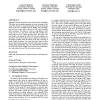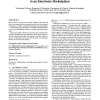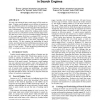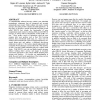WWW
2003
ACM
15 years 8 days ago
2003
ACM
Links are one of the most important means for navigation in the World Wide Web. However, the visualization of and the interaction with Web links have been scarcely explored, altho...
WWW
2003
ACM
15 years 8 days ago
2003
ACM
The World-Wide Web was originally developed as a shared, writable, hypertext medium, a facility that is still widely needed. We have recently developed a Web-based management repo...
WWW
2003
ACM
15 years 8 days ago
2003
ACM
Although originally designed for large-scale electronic publishing, XML plays an increasingly important role in the exchange of data on the Web. In fact, it is expected that XML w...
WWW
2003
ACM
15 years 8 days ago
2003
ACM
More and more resources are becoming available on the Web, and there is a growing need for infrastructures that, based on advertised descriptions, are able to semantically match d...
WWW
2003
ACM
15 years 8 days ago
2003
ACM
RDF-based P2P networks have a number of advantages compared with simpler P2P networks such as Napster, Gnutella or with approaches based on distributed indices such as CAN and CHO...
WWW
2003
ACM
15 years 8 days ago
2003
ACM
WWW
2003
ACM
15 years 8 days ago
2003
ACM
WWW
2003
ACM
15 years 8 days ago
2003
ACM
The vision of the Semantic Web can only be realized through proliferation of well-known ontologies describing different domains. To enable interoperability in the Semantic Web, it...
WWW
2003
ACM
15 years 8 days ago
2003
ACM
A computationally enhanced message contains some embedded programmatic components that are interpreted and executed automatically upon receipt. Unlike ordinary text email or insta...
WWW
2003
ACM
15 years 8 days ago
2003
ACM
We propose two new tools to address the evolution of hyperlinked corpora. First, we define time graphs to extend the traditional notion of an evolving directed graph, capturing li...




